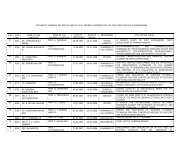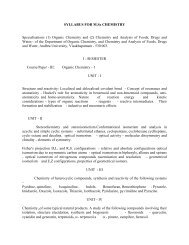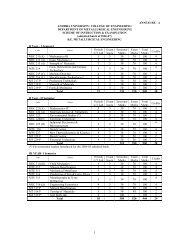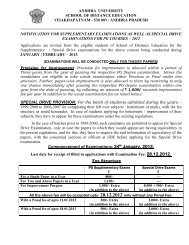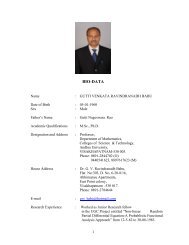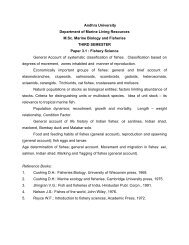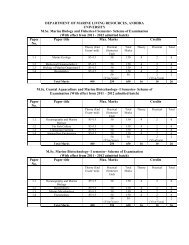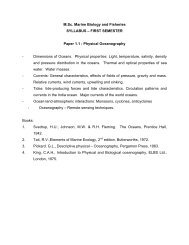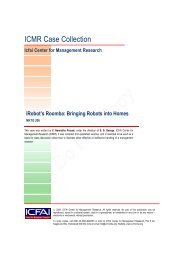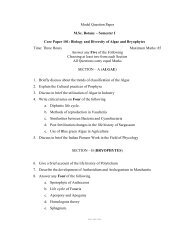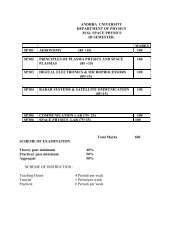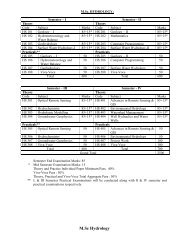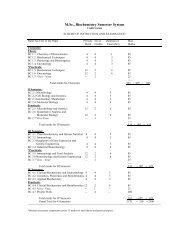M.Sc. MARINE GEOPHYSICS - Andhra University, Visakhapatnam
M.Sc. MARINE GEOPHYSICS - Andhra University, Visakhapatnam
M.Sc. MARINE GEOPHYSICS - Andhra University, Visakhapatnam
Create successful ePaper yourself
Turn your PDF publications into a flip-book with our unique Google optimized e-Paper software.
M.<strong>Sc</strong>. <strong>MARINE</strong> <strong>GEOPHYSICS</strong>:<br />
Semester – I Semester - II<br />
Theory Theory<br />
Code Subject Marks Code Subject Marks<br />
MGS 101 Geology – I 85+15* MGS 201 Geology – II 85+15*<br />
MGS 102 Signal Processing & 85+15* MGS 202 Mathematics 85+15*<br />
Inversion Theory<br />
MGS 103 Physics of the Earth 85+15* MGS 203 Computer Programming 85+15*<br />
MGS 104 Seismology 85+15* MGS 204 Geomagnetism 85+15*<br />
Practicals** Practicals<br />
MGS 105 Geology – I 50 MGS 205 Geology – II 50<br />
MGS 106 Seismology 50 MGS 206 Computer Programming 50<br />
MGS 107 Viva-Voce 50 MGS 207 Viva-Voce 50<br />
Total 550 Total 550<br />
Semester – III Semester - IV<br />
Theory Theory<br />
Code Subject Marks Code Subject Marks<br />
MGS 301 Seismic Methods – I 85+15* MGS 401 Seismic Methods – II 85+15*<br />
MGS 302 Gravity Method 85+15* MGS 402 Magnetic Method 85+15*<br />
MGS 303 Principles of Well Logging 85+15* MGS 403 Well Logging & Reservoir 85+15*<br />
Analysis<br />
MGS 304 Marine Geophysics 85+15* MGS 404 Geodynamics 85+15*<br />
Practicals** Practicals<br />
MGS 305 Seismic Methods – I 50 MGS 405 Seismic Methods – II 50<br />
MGS 306 Gravity Method 50 MGS 406 Magnetic Method 50<br />
MGS 307 Well Logging 50 MGS 407 Project Work 100<br />
MGS 308 Marine Geophysics 50 MGS 408 Viva-Voce 100<br />
MGS 309 Viva-Voce 50<br />
Total 650 Total 700<br />
Grand Total 2450<br />
Semester End Examination Marks: 85<br />
* Mid Semester Examination Marks: 15<br />
Theory and Practice Individual Paper Minimum Pass: 40%<br />
Viva-Voce Pass : 50%<br />
Theory, Practical and Viva-Voce Total Aggregate Pass : 50%<br />
** I, & III Semester Practical Examinations will be conducted along with II & IV semester end<br />
practical examinations respectively.
M.<strong>Sc</strong> Marine Geophysics<br />
MGS-101 GEOLOGY - I<br />
UNIT I: Basic assumptions in Geology, relation of geology with sciences-branches of geologyfigure<br />
and dimensions of earth, structure, composition and origin of earth-Envelops of the<br />
earth-crust, mantle, core, External dynamic process- weathering, geological work of<br />
wind-weathering, erosion and denudation, cycle of erosion, transportation and deposition<br />
agents-loess, relief. Desert types.<br />
UNIT II: Geological work of surface flowing water-streams, rivers, their development. River<br />
systems-meandering, oxbow lakes, flood plains, peneplains and deltas. Geological work<br />
of underground water-permeability of rocks, types of water in rocks-classification of<br />
underground water-springs. Minerals waters-carbonate, sulphide and radioactive waters.<br />
Karst-forms, landslides, lakes and swamps, estuaries. Internal dynamic process-tectonic<br />
dislocations, neotectonics, earthquakes. Magmatism-volcanoes. Geological work of the<br />
sea-marine basins-relief features of the world, ocean floor. Temperature, salinity of<br />
seawater. Destructive work of sea-near shore accumulation forms-sedimentation in<br />
various zones of sea. Distribution of marine sediments.<br />
UNIT III: Fundamental concepts in geomorphology-geomorphic processes-distribution of<br />
landforms-drainage patterns -development. Morphometric analysis of drainage basins,<br />
water sheds. Elements of hill slopes-pediment, bazadas. Landforms in relation to rock<br />
types, paleochannels, buried channels. Soils types and their classification. Evolution of<br />
major geomorphic process in India. Marine geomorphic processes, coastal<br />
morphological processes. Field and laboratory map scales, topographic maps, thematic<br />
maps, topographic and geomorphic profiles.<br />
UNIT IV: Structural, textural, and chemical classification and origin of igneous, metamorphic and<br />
sedimentary rocks- Petrogenisis, granitisation. Petrographic characters of pegmatites,<br />
kimberlites and gondites- Sedimentary structures- petrographic characters of<br />
conglomerate, sandstone, shale, limestones. Process of dolamitisation. Metamorphismstructural<br />
classification of shale, phyllite, schist, gneiss, marble quartzite and granulites.<br />
UNIT V: <strong>Sc</strong>ience of minerals, physical and optical properties of minerals. Classification, structure<br />
and chemistry of Feldspar, Mica, Pyroxenes, Amphiboles, Olivine, Quartz and Garnet<br />
groups. Clay minerals, genesis and chemistry of native elements. Elements of<br />
crystallography, crystallographic axes, symmetry form of crystals and classification of<br />
crystals.<br />
Books:<br />
l. Physical Geology, G.Gorshkov, A.Yakushova<br />
2. Physical geology, A.K.Datta<br />
3. A textbook of Geology, P. K Mukherjee.<br />
4. The principles of petrology, G.W.Tyrell.<br />
5. Rutleys mineralogy, H.M.Read<br />
6. Physical Geology, Arthur Holmes
MGS 102: Signal Processing and Inversion Theory<br />
Unit I Introduction, Definition of signal and noise, various signal classes such as continuous,<br />
piece wise continuous, absolute integrable, singularity, unit impulse, unit step, etc.Fourier<br />
series and Fourier Transfors: Time and frequency domain, relations between various<br />
operations in both the domain, Fourier Transform and its properties, Fourier Transforms<br />
of some important functions: Rectangular, exponential functions, singularity functions<br />
and periodic functions.<br />
Unit II Time-series analysis: Discrete time signals, Correlation and convolution functions,<br />
impulse response and Transfer function spectrum of observational data: Discrete Fourier<br />
Transform (DFT), FFT, Z-Transforms, Delay properties of wavelets.<br />
Unit III Band limited signals: Properties, Sampling Theorem, Nyquist frequency, Aliasing,<br />
Sampling of band and time limited signals; Effect of sampling on spectrum and viceversa;<br />
reproduction of continuous function from sampled data.<br />
Importance and effects of Windowing, Gibbs phenomenon, spectral leakage, various<br />
types of windows; power spectrum; Estimation of power spectrum, Wiener Khinchin<br />
theorem, use of various windows in power spectrum computation, spectrum computation<br />
via Auto-correlation and Periodogram.<br />
Unit IV Digital filtering: Design of digital filters, amplitude and phase response of various filters;<br />
one-sided and two sided filters, low-pass, high pass and band-pass, optimum filters,<br />
Butter worth filter, Recursive and non-recursive filters, optimal and Weiner filters,<br />
Deconvolution and predictive deconvolution.<br />
Unit-V Inversion Theory: Introduction, Fundamentals of Inversion, Linear Inversion, Non-Linear<br />
Inversion, Incorporating prior information, Parametric Inversion, Assessing the<br />
uncertainty in inverted models.<br />
Books: 1. Spectral analysis in Geophysics, Markus Bath<br />
2. Theory and application of digital signal processing, Rabiner,L.R and<br />
Gold, B.<br />
3. Digital signal processing and time series analysis, Enders A.Robinson<br />
4. Statistical theory of communication, Y.W.Lee<br />
5. Analysis of Geophysical Potential Fields, P.S.Naidu & M.P.Mathew<br />
6. Seismic Filtering, Nathan Rothenburg, SEG publication<br />
7. Time sequence analysis in Geophysics, E.R.Kanasewich<br />
8. Signal Analysis, B.P.Lathy<br />
9. Inverse problem theory, Tarantola.A,1987<br />
10.Solutions of ill-posed problems, Tikhonov.A.V, and Arsenin.V.Y, 1977<br />
11.Computational methods for Inverse problems, Vogel.C.R,
MGS 103: PHYSICS OF THE EARTH<br />
Unit I: Origin of the earth- the Universe and our galaxy, chemical evolution of galaxy formation<br />
of the earth and planets, primary differentiation of the earth. Composition of the various<br />
zones, abundance of elements in the earth, the rotation of the earth, the moon, salient<br />
concepts of plate tectonics.<br />
Unit II: The earth's gravity field, the force of gravity on the surface of the earth, the figure of the<br />
earth, Clairaut's theorem, the geometric and gravitational flatten! International gravity<br />
formula, geoid and spheroid, the gravity potent establishment of gravity bases, drift<br />
correction, reduction of gravity data, free and Bouguer anomalies, Isostasy - Pratt -<br />
Hayford, Airy - Heiskanen system anomalies.<br />
Unit III: Geochronology, Radioactive decay. Dating of rocks - potassium-argon – rubidium<br />
strontium-uranium-lead-carbon 14 methods, age of the earth. The earth's thermal<br />
properties, the basic thermal data, the measurement of terrestrial flow, calculation and<br />
analysis of heat flow rate, heat flow over the ocean floor, flow over continents, sources of<br />
heat in the earth, temperature distribution in earth. The equality of continental and<br />
oceanic heat flows, regions of anomalous flow, hot spots, relation ship of heat flow to the<br />
radioactivity of the earth.<br />
Unit IV: The atmosphere, composition - internal structure, prevailing and adiabatic lapse rates,<br />
instability of dry and moist air, geo potential, cloud classification, condensation nuclei,<br />
artificial precipitation, fundamental forces in the atmosphere, coriolis force and the geo<br />
strophic winds, monsoon systems, cyclones, anticyclones and tornadoes, air masses and<br />
fronts, jet streams, climate and climatic changes, ozone and other trace gases.<br />
Unit V: Hydrology - definition, hydrologic cycle, vertical distribution of groundwater types of<br />
aquifers, Darcy's law, porosity, permeability - laboratory measurement, well hydraulics -<br />
steady and unidirectional flow, quality of groundwater, concepts of water balance, sea<br />
water intrusion in coastal aquifers.<br />
Books:<br />
1. Introduction of Geophysics, Howell<br />
2. Physics and Geology, Jacobs and Russel<br />
3. Physics of the earth, Stacy<br />
4. The interior of the earth, M.H.P. Bott<br />
5. Topics in Geophysics, P.J. Smith<br />
6. Fundamentals of Geophysics, William Lowrie<br />
7. Groundwater Hydrology, D.K. Todd<br />
8. General Climatology, HJ. Critchfield<br />
9. Earth ,Press & Siever
MGS-104 SEISMOLOGY<br />
Unit I: Introduction to seismology. Earthquakes and Plate Tectonics: Plate kinematics, Spreading<br />
centers, and Subduction zones. Oceanic interplate seismicity, Continental earthquakes<br />
and tectonics. Faulting and Fracture, Secondary effects of earthquakes: landslides,<br />
tsunami, fires and fatalities, Seismicity of India and Globe, Seismic zoning. Earthquake<br />
effects and hazards. Elastic waves- Elastic, Anelastic and Plastic behavior of materials.<br />
Stress, Strain, elastic constants. Seismic waves- Introduction, Body waves. Surface<br />
Waves, Types and Phases of waves. Free oscillations of the Earth, the internal Structure<br />
of the Earth- Refraction and Reflection in the earth's interior. Types of Earthquakes.<br />
Unit II: Seismometry: Introduction, Principle of Seismometer, Vertical motion seismometer, and<br />
Horizontal motion seismometer. Broad Band seismometer, Analog recorders. Digital<br />
recorders, Seismogram- Identification of Phases on a seismogram. Selection of<br />
seismograph stations. Global seismic network<br />
Unit III: Seismic Sources - Faults, Introduction of earthquake focal mechanism, Single- Couple<br />
and Double couple radiation patterns. Fault-plane solutions. Mechanics of faulting,<br />
Travel-Time curves, locating earthquakes.<br />
Unit IV: Seismogram Interpretation, Earthquake intensity Magnitude, Frequency, Energy released<br />
in an earthquake. Epicenter determination. Analysis of earthquake focal Mechanism.<br />
Unit V: Micro earthquakes- Analysis and interpretation of seismograms, Reservoir induced<br />
earthquakes. Prediction of location of the earthquake. Earthquake control. Monitoring of<br />
Nuclear explosions.<br />
Books:<br />
1. Fundamentals of Geophysics, William Lowrie<br />
2. Modem Global Seismology, Thorne Lay<br />
3. Earthquakes, Bolt, B.A.,<br />
4. Introduction to Seismology, Perry Byrle<br />
5. The Earth, Jeffreys.S.H.<br />
6. Elementary Seismology, Charles.F. Richter<br />
7. Earthquake Mechanics, Kasahara. K.<br />
8. The Mechanics of Earthquakes-faulting, <strong>Sc</strong>holtz.C.H.<br />
9. An introduction to the theory of seismology, Bullen. K.E.<br />
10. Quantitative seismology: theory & methods, Aki. K. and Richrds. P.G
MGS-201 GEOLOGY - II<br />
UNIT I: Objectives of structural geology-composition and resolution of forces-stress, strain.<br />
Description of folds. Classification, mechanics and causes of folding. Foliation and<br />
lineation. Classification of faults, brittle and ductile structures, shearing and shear zones.<br />
Classification of unconformities. Map patterns and their uses in determination of large<br />
scale structures. Tectonic evolution of Dharwars, Eastern Ghats, Aravalis, Singhbhum<br />
and Cuddapahs. Evolution of Himalayas and tectonics. Outlines of geological mapping.<br />
UNIT II: Earth and stratified rocks-importance of stratigraphy-geological cycle and time scale.<br />
Stratigraphic nomenclature and classification. Sargur, Dharwar, Singhbhum super<br />
groups, Aravalis and Eastern Ghat Mobile Belts, Cuddapahs, Vindyan and Kurnool<br />
systems, Deccan basalts, Cretaceous formations, and quaternary formations- boundary<br />
problems in stratigraphy.<br />
UNIT III: Geochemical cycle, geochemical exploration methods, classification of elements.<br />
Analytical techniques for geochemical analysis. Outlines of standards preparation.<br />
Instruments and their exposure. Elements of ore petrology, characteristic features and<br />
genesis of ferrous and non-ferrous ore deposits of India. Mettalogeny, origin, migration<br />
and entrapment of petroleum deposits. Properties of source and reservoir rocks.<br />
Petroliferous basins of India- an outline. Classification of coal, ranking, and grading of<br />
coal deposits of India.<br />
UNIT IV: Physiography and divisions of seas and world oceans. Properties of sea water-salinity,<br />
temperature, density. Littoral and sublittoral zones. Continental shelves, slopes, deep<br />
sea, aprons, seamounts and guyots, abyssal plains- Mid ocean ridge system, aseismic<br />
ridges. Coral reefs and their formation. Tectonic domains of oceans, island arcs, trenches,<br />
hotspot mechanism. Turbidity currents and deep sea sediments, placers on the beach and<br />
shelfs, conditions for formation of polymettalic nodules. Law of the seas.<br />
UNIT V: Orogency-continental drift hypothesis-breakup of continents-plate tectonics-convergent<br />
and divergent margins, eustatic changes of sea level, lithosphere. subduction, obduction<br />
and benioff zones, plate margins, mineralisation near plate margin, major and minor<br />
plates. Transform and transcurent faults, driving mechanism of the plates, convection<br />
currents, triple junction, movement of Indian subcontinent. Origin and evolution of life,<br />
fossils and their uses. Biomineralisation studies on fossils, pale ecology, oxygen and<br />
carbon isotopic studies on fossils, and analysis of paleontoiogical record for tracing plate<br />
tectonic process.<br />
Books :<br />
1. Sub marine geology, P.H.Kunen<br />
2. Submarine geology, F.P.Sheppard.<br />
3. Stratigraphy of India, M.S.Krishnan<br />
4. Structural Geology, M.P.Billings<br />
5. Geochemistry, Rankama and Sahama<br />
6. Economic mineral deposits, A-M.Bateman and M.N.Jenson<br />
1. Aspects of Tectonics, focus on south central India, K.S.Valdiya
MGS-202 MATHEMATICS<br />
Unit I: Line Integrals, Green's theorem in two-dimensions. Complex Integration, Cauchy' s<br />
Integral theorem, Cauchys Integral formula, Types of Residues, Cauchy's Residue<br />
Theorem, Evaluation of certain improper integrals involving trigonometric functions.<br />
Unit II: Matrices: Principles and definitions, Single value decomposition method. Introduction to<br />
various generalized inversion techniques and their properties. Least square polynomial<br />
approximation: the principle of least squares, least square approximation over discrete<br />
sets of points, Chebysev Polynomial.<br />
Unit III: Numerical Analysis; finding the roots by numerical methods- bisection method, False<br />
position method, Newton-Raphson method. Interpolation: finite difference, symbolic<br />
relations. Interpolation by Newtons formula. Gauss's Central difference formula, Bessel’s<br />
formula, Lagrangian formula and Richardson's extrapolation. Numerical differentiation<br />
and Integration: Maximum and minimum of a tabulated function. Numerical<br />
Integration-Trapezoidal rule, Simpson' s rule, Romberg integration, Weddle's formula.<br />
Unit IV: Numerical solution of differential equations- Introduction, Solution by Taylor series,<br />
Picard's method of successive approximation, Eulers method, Runga-Kutta method.<br />
Finite element methods: Basic concept of the finite element method. Boundary and Initial<br />
value problem, Variational formulation of boundary value problem, Variational methods<br />
of approximation- The Ritz method. Introduction to finite element analysis of I-D and 2-<br />
D problems.<br />
Unit V: Introduction to Classical Optimisation Techniques, Introduction to Linear Programming<br />
and Non-linear Programming, One dimensional minimization methods- Introduction,<br />
Fibonacci method. Introduction to unconstrained optimisation techniques. Introduction<br />
of Steepest descent method, gradient techniques and Marquardt's method.<br />
Books :<br />
1. Higher mathematics for Engineering and <strong>Sc</strong>ience, M.K.Venkata Raman<br />
2. Engineering mathematics, M.K.Venkata Raman<br />
3. Complex Variables, R-C.Churchill<br />
4. Matrix theory for scientific and engineers, Jennings<br />
5. Generalized inverse of matrices and its application, C.K.Rao & S.R.Mitra<br />
6. An Introduction to Finite Element Method, J.N.Reddy<br />
7. Introduction to Numerical analysis, S.S.Sastry<br />
8. Introduction to Numerical analysis, F.B.Hiderbrand<br />
9. Optimisation theory and application, S.S.Rao
MGS 203: Computer programming<br />
Unit I: Introduction: General architecture of a computer. Types of computers. Advantage of<br />
digital computers, structure of a computer, programming languages, object program,<br />
compilers and assemblers.<br />
Unit II : Computer Operating systems: Different types of operating systems: Single user<br />
operating system- MSDOS; Basic structure of DOS, DOS commands, Control-<br />
Function keys. DOS editing keys. Formatting etc.; Multi-tasking operating system-<br />
MS WINDOWS, Basic concepts of windows. Advantages of WINDOWS over<br />
MSDOS; Multi-user and multi-tasking operating systems- UNIX, File system in<br />
UNIX, File mangement, UNIX commands and Shell programming.<br />
Unit III: Programming Languages: Structure of FORTRAN-77, programming<br />
'preliminaries, compilation and execution; FORTRAN expressions-<br />
Arithmetic expressions, order of computation, use of parenthesis, value and mode of<br />
expression. Library functions-Flow Charts; Control statements - GOTO, Computed<br />
GOTO and Assigned GOTO statements; Logical expressions, different types of IF<br />
statements. DO statement. Nesting of Control statements, STOP, END and PAUSE<br />
statements; subscripted variables. Arrays and DIMENSION statement; Special<br />
statements - COMMON, DATA statements. Input and Output statements;<br />
Subprograms - Arithmetic statement functions. Function and Subroutine<br />
subprograms, Compilation and debugging.<br />
Unit IV : BASIC programming language: Introduction, Constants, variables and<br />
expressions in BASIC; Input of data. Conditional and loop structure, control<br />
statements, GO SUB functions<br />
UnitV: C programming language: Basic concepts of C; Symbolic and arithmetic<br />
constants and variables; Data types in C Decision control. Loop control and Case<br />
control structures in C; Functions; Pointers and Arrays; Input and Output; Interation<br />
with Hardware through C and Operations on Bits; Some selected Geophysical<br />
problems and their C programs.<br />
Books:<br />
1. Fortran programming. A.K. Jain & M.N.Kesava Rao<br />
2. Fortran 77 programming, V.Rajararnan ,<br />
3. Let us C, Yashavant Kanetkar<br />
4. UNIX shell programming , Yashavant Kanetkar
GS -204: GEOMAGNETISM<br />
Unit I: The main magnetic field, magnetic observatories, Instruments - proton precision magneto<br />
meter, magnetic elements, magnetic charts, the magnetic dipole, the magnetic field of an<br />
electric current, separation of magnetic fields of external and internal origin, the magnetic<br />
field of the external origin, ionosphere, magnetosphere, diurnal variations of magnetic field,<br />
Sq and L variations, magnetic storms and Aurora.<br />
Unit II: The magnetic field of the internal origin, IGRF, the dipole field, the non – dipole field,<br />
secular variation and west ward drift, magnetic fields of the Sun, Moon and planets, theories<br />
on the origin of earth's magnetic field, the permanent magnet hypothesis, Blackett's theory,<br />
the earth as a dynamo, the disc dynamo, dynamo of Lowes and Wilkinson.<br />
Unit III: Magnetic properties of rocks, dia, para and ferromagnetism, the ternary oxide system of<br />
magnetic minerals, the titanomagnetite series, the titanohematite series, other ferromagnetic<br />
minerals. Magnetic susceptibility of rocks, NRM in rocks, measuring instruments. Spinner<br />
magnetometer, Cryogenic magnetometers.<br />
Unit IV: Palaeomagnetism, remanant magnetism in rocks, TRM, DRM, CRM, VRM, hysterisis curve.<br />
Isolation of remnance, cleaning methods. AF demagnetization, thermal demagnetization,<br />
laboratory procedure, tests for stability.<br />
UnitV: Reversals of the magnetic field, polarity of the geomagnetic field, geomagnetic scale,<br />
projective method of presenting palaeomagnetic data, magnetic latitude and co - latitude,<br />
calculation of mean direction of virtual geomagnetic poles, palaeomagnetic poles,<br />
reconstruction of palaeomagnetic poles, continental drift, northward drift of India, results<br />
from different continents.<br />
Books<br />
1. Debate about the Earth, H. takenchi, S. Uyeda and H. Kanamori<br />
2. Fundamentals of Geophysics, William Lowrie<br />
3. Geomagnetism, Sydney Chapman<br />
4. Application of Palaeomagnetism, E. Erwing<br />
5. Palaeomagnetism and Continents, J D A Piper<br />
6. Palaomagnetism and Plate tectonics, M W McElhimy
MGS 301 : Seismic Methods-I<br />
Unit –I Principles of elasticity: Normal strains, shearing strains, Hook’s law, Elastic moduli,<br />
wave equations, Huygen’s & Fermat’s Principles, Zeoppritz equations, refraction,<br />
reflection, critical refraction, diffraction, attenuation & absorption of seismic waves,<br />
acoustic impedance, surface waves, dispersion multiples, reflection and transmission<br />
coefficients.<br />
Unit- II Elastic wave velocities of rocks: laboratory and field measurements, dynamic moduli, P<br />
and S-wave velocities, anisotropy, attenuation, factors affecting velocity, different types<br />
of velocities, geometry of ray paths, refraction and reflection, horizontal layers and<br />
dipping layers, NMO and dip move out, discrete and continuous velocity changes,<br />
velocity inversion, low velocity layer, blind zone, hidden layer.<br />
Unit-III Electromagnetic geophone and its performance, damping coefficient, hydrophones,<br />
detector arrays, array response, uniform arrays, amplitude weighted arrays, distance<br />
tapered arrays, streamer, analog data acquisition, amplifiers, filters, gain control and<br />
recording types. Seismic energy sources for land and marine surveys. Dynamite<br />
thumper, dinosies, vibrosies, land air gun, pinger, boomer, sparker, airgun, water gun,<br />
vaporchoc etc. Controlled explosions, shot control, source arrays, energy content,<br />
frequency, pulse length and resolution, penetration, signatures of energy sources.<br />
Unit-IV Digital data acquisition, digital field system, signal flow and recording. Constituent units<br />
and modules. Telemetry systems, wireline and radio telemetry, telemetry system<br />
configuration and specifications, dynamic range of signals noise: shot generation,<br />
ambient and electrical noises, their nature and attenuation requirements. Noise survey,<br />
noise analysis, fold back experiment, optimization of parameters.<br />
Unit – V Single channel and multi channel surveys, field layouts and shooting procedures for land<br />
and marine 2D surveys, split spread and end-on spreads, CDP procedures for land and<br />
marine surveys, stacking chart. 3D surveys, 3D layouts, swath, brick, odds & evens, zig<br />
zag, button patch, full range 3D, loop survey. Marine 3D shooting: two streamer system,<br />
alternate shooting, two boat operation, circles shooting, 3D bottom cable survey, quad<br />
quad 3D, multiple streamers, static binning and dynamite binning. Refraction surveys:<br />
Field procedures, fan shooting, broad side shooting, inline profiling, long refraction<br />
profiles, reversed and unreversed profiles, marine refraction surveys, sonobuoy surveys.<br />
(VSP, shear wave data acquisition and other special surveys procedures are included in<br />
paper II along with processing and interpretation of seismic data)<br />
Books: 1. Introduction to geophysical prospecting, M.B.Dobrin.<br />
2. Applied Geophysics, W.M.Telford et. al.<br />
3. Exploration seismology, Sheriff. R.E.<br />
4. Seismic exploration fundamentals, J.A.Coffeen.<br />
5. A hand book for seismic data acquisition, Brain J Evans<br />
6. Designing seismic surveys in two and three dimensions, Dale G Stone<br />
MGS 302: Gravity Method
Unit I Earth’s Gravity field, Properties of Newtonian potential, Laplace’s and Poissons’s<br />
equations, Green’s theorem, Gauss law, continuation integral, equivalent stratum, spatial<br />
and temporal variations, Principle of gravity prospecting, concept of gravity anomaly.<br />
Rock densities, factors controlling rock densities, Bouguer density, Insitu determinations,<br />
Borehole methods. Gravity prospecting instruments – Static gravimeters, Astatization,<br />
Zero-length spring, Worden & Lacoste Romberg Gravimeters.<br />
Unit II Plan of Gravity surveys – mineral exploration, oil prospecting and Geological mapping,<br />
Establishment of gravity bases, drift correction. Problems in airborne and shipborne<br />
gravimetry, horizontal and vertical accelerations, Eotvos correction. Application of<br />
gravity methods for regional geological mapping, Oil exploration – salt domes, structural<br />
traps, mineral exploration – sulphide ores, ferrous and non-ferrous ores, diamonds, placer<br />
deposits, groundwater and Engineering problems.<br />
Unit III Interpretation of gravity data – Qualitative interpretation, identification of structural<br />
features and litho contacts, two-dimensional and three-dimensional bodies - nature of<br />
anomalies. Regional and residual separation – graphical, average , grid and curve fitting<br />
methods, reliability of different types of residuals, use of filters, vertical derivative<br />
calculations, upward and downward continuation of anomalies, classical methods using<br />
continuation integral, employing harmonic analysis and Fourier Transformation.<br />
Unit IV Ambiguity in gravity interpretation, classical method of interpretation, gravity anomalies<br />
of point and line masses, circular discs, vertical cylinders, sheets, faults and rectangular<br />
slabs, Characterstics of anomalies, properties, interpretation by simple thumb rules and<br />
characteristic curves.<br />
Unit V Forward modeling of gravity anomalies of two-dimensional and three-dimensional bodies<br />
of arbitrary shape, Graticules, computer models, anomalies of two-and-half-dimensional<br />
bodies, Inversion of gravity anomalies of 2-D polygonal bodies, Automatic gravity<br />
modeling of sedimentary basins and density interfaces by Bott’s method. Modeling of<br />
gravity anomalies using linear, exponential and quadratic density contrast. Use of<br />
Fourier Transforms in Gravity interpretation, Mass estimation in gravity.<br />
Books: 1. The Earth and its gravity field, A.A.Heiskanen and F.A Vening<br />
2. Gravity and magnetics in oil prospecting, L.L.Nettleton<br />
3. Gravity and magnetic methods, Rao, B.S.R and Murthy, I.V.R<br />
4. Gravity and magnetic Interpretation in Exploration Geophysics,<br />
I.V.Radhakrishna Murthy<br />
5. Marine Gravity, Peter Denelinagar<br />
6. Applied Geophysics, W.W.Telford et. al<br />
7. Introduction to Geophysical prospecting, M.B.Dobrin<br />
8. Interpretation theory in Applied Geophysics, F.S.Grant and West.<br />
MGS 303 : PRINCIPLES OF WELL LOGGING
Unit I: Introduction: Drilling of a Well. Drilling Fluids. Mud Filterates, Invasion Profile Logging Unit.<br />
Depth Control. Well Pressures, Bore Hole Environment, Formation Factor. Porosity & Water<br />
saturations, Occurrences of Hydrocarbons, Minerals and Water, Tool design and Tool Principles.<br />
Unit II: Electrical logging: S.P Log: Origin, Static SP, Shale Base Line, SP in various acquifers,<br />
Determination of Rw, Conventional Resistivity Logs; Normal, Lateral Curves, Focussed Logs:<br />
Latero Log - 3. Latero Log-7, DLL, SFL and Comparative study, Induction Log: DIL, HRI-High<br />
Resolution Induction Log. Micro Log, Micro & Micro Latero Log, Micro SFL. Determination of<br />
Rmf, Rxo & Rt. Dipmeter. Side Wall Coring, Logging for Ground Water, Coal & Minerals<br />
Unit III Radioactive Logs: Principles of Radioactivity, Counters, Gamma Ray Log Statistical Variations,<br />
Neutron - Gamma,, Neutron - Neutron Logs, Thermal Decay logs, Density Log, Oxygen Log,<br />
CNT tool, SNP correction. Identification of Lithology, & Porosity. CMR Log: and identification<br />
of free fluids.<br />
Unit IV: Sonic Logs: Transit Time, BHC tool, Sonic Velocities, Sonic Porosities Cementation. Cased<br />
Hole Logs-CBL - VDL. Identification of Water, Minerals and Hydrocarbons and fractures.<br />
Unit V: Interpretation of Log data: Lithology & Porosity determination from cross plots. Permeability<br />
determination, M-N Plots. Common Sedimentary rocks. Clean and Shaly formations, Cross Plots<br />
Techniques, Quick look interpretation and detailed interpretation of Clean sands and Shaly sands,<br />
Water Saturation. Identification of Hydrocarbon zones, Mineral Zones, water Zones and Coals.<br />
Books:<br />
1. Formation Evaluation- E J Lynch<br />
2. Induction Logging- Plusynin.<br />
3. Log Interpretation Principles and Charts - <strong>Sc</strong>hlumberger<br />
4. <strong>Sc</strong>hlumberger Documents,<br />
5. Development and Exploitation of Oils and Gas Fields - Murovyer and Andiasevrentnal<br />
6. Handbook of Well Log Analysis - S J Peterson.
MGS 304: <strong>MARINE</strong> <strong>GEOPHYSICS</strong><br />
Unit I: Oceans and Seas, origin of continents and oceans, salinity, temperature and density of sea water,<br />
physiography and divisions of the sea floor, continental shelves, slopes and aprons, submarine<br />
canyons and deep sea channels, sea mounts and abyssal plains, turbidity currents and submarine<br />
sedimentation, the mid oceanic ridge systems and its structure, aseismic ridges, various types of<br />
ridges in the Indian ocean region, the continental fracture system and island arcs, occurrence of<br />
offshore mineral deposits and hydrocarbons, hotspots lithospheric deformation of central Indian<br />
ocean region, mineral resources of the sea: surficial deposits of the shelf and deep sea, heavy<br />
mineral placers, calcareous shells, pearl oysters, phosphorites, glauconite, barium sulfate<br />
carcretions, sand and gravel, extensions of ore deposits, hydrocarbon potential of the shelf and<br />
offshore sedimentary basins.<br />
Unit II: Geophysical instrumentation and surveys: Adaptation of geophysical instruments for marine<br />
surveys, for measurements at the sea surface and under water, geophysical equipment currently in<br />
use and board research vessels, complement of equipment on board the survey ship and layout of<br />
equipment, towing logistics, survey procedures and planning of survey lines, marine<br />
magnetometers, marine gravimeters, surface and under water gravimeters, Graf Askanian, Lacoste<br />
Romberg and vibrating string gravimeters, calculation of gravity anomalies.<br />
Unit III: Bathymetry; echosounding, bathymetric charts, bathymetry as an adjunct to geophysical surveys,<br />
submersibles, seabed mapping by side scan sonar, multibeam, lider and other surveys, seabed<br />
sampling, dredging and coring, marine geophysical surveys for sealed resources, site selection for<br />
production platforms, tunneling, waste disposal etc.<br />
Unit IV: Oceanic magnetic anomalies, sea floor spreading, the Vine-Mathews hypothesis, geomagnetic time<br />
scale and dating the ocean floor, linear magnetic anomalies. Heat flow: Earth's internal sources of<br />
heat, transfer of heat within the earth, measurements at the ocean bottom, heat flow probes and<br />
measurements. Oceanic heat flow, ocean ridges and ocean basins, marginal basins, rift valleys.<br />
Unit V: Objectives of marine geophysical surveys, marine geophysical surveys for sea bed resources,<br />
engineering investigations, deep sea geological mapping, delineation of continent-oceanic<br />
boundary, geological mapping in the coastal zone. Results of some rare studies. Geophysical<br />
anomalies of trenches, active and passive margins, ridges, island arcs, lithospheric deformation in<br />
the Indian Ocean region etc. Large scale and small-scale structural features of the oceanic crust<br />
from seismic surveys (velocity structure)<br />
Books:<br />
1. Marine geophysics by EJW Jones<br />
2. Physics and geology by Jacobs, Russel and Wilson<br />
3. Introduction to geophysical prospecting by MB Dobrin<br />
4. Applied geophysics by WM Telford, et. Al.<br />
5. Geodynamic Turcuttoe<br />
6. The interior of the Earth by MHP Bott.
MGS-401: Seismic methods – II<br />
Unit –I Reduction of refraction data, interpretation of refraction data, analysis of refraction<br />
records, interpretation of reversed and unreversed profiles, delay time methods, forward<br />
modeling, masked layers and hidden layers, reduction and interpretation of sonobuoy<br />
data, crustal seismology, engineering surveys, exploration for ground water, application<br />
in mining industry.<br />
Unit- II Reflection data processing, static and dynamic corrections, velocity determination.<br />
Preparation of seismic sections migration, analysis of analog records, automatic<br />
processing of digital seismic data, demultiplexing, TAR, velocity analysis, velocity<br />
spectra and velocity scan, automatic statics, picking, stacking, spiking deconvolution,<br />
dereverberation, whitening, time variant frequency filtering, apparent velocity filtering.<br />
AVO analysis, different methods of migration, automatic migration, wavelet processing.<br />
Unit-III Seismic section plotting, display types, picking of events, marking-isochron & isopach<br />
maps, geological interpretation, application of reflection methodl exploration for oil and<br />
gas, groundwater, coal, mineral deposits, gas hydrates, etc., engineering applications,<br />
crustal studies, structural and stratigraphic traps, identification of geological structures<br />
like anticlines, faults, salt domes etc; fit falls in interpretation.<br />
Unit-IV hydrocarbon indicators, bright spot, seismic attributes, AVO analysis, vertical seismic<br />
profiling, equipment, configurations like deviated well, walk away, offset VSP etc.,<br />
applications, 3D data processing and interpretation, visualization in an animated<br />
interactive environment.<br />
Unit – V Seismic stratigraphy, geological sea level change model, depositional patterns, seismic<br />
sequence, seismic facies, reflection character, synthetic seismogram, modeling concepts,<br />
high resolution seismic surveys, shallow engineering surveys and suitable energy sources,<br />
4C, 4D recording, seismic tomography, reservoir applications of petrophysics concepts,<br />
generation and recording of shear waves, energy sources, geophones, recording,<br />
processing, section plotting, interpretation Vp/Vs as lighology indicator, hydrocarbons,<br />
engineering applications.<br />
Books:<br />
1. Introduction to geophysical prospecting, M.B.Dobrin.<br />
2. Applied Geophysics, W.M.Telford et. al.<br />
3. Exploration seismology, Sheriff. R.E.<br />
4. An introduction to seismic interpretation, R. Mcquillin et.al.<br />
5. Seismic stratigraphy-application to hydrocarbon exploration Ed. By Charles Payton.<br />
6. Shear wave exploration, SH Danbom and SN Domenico<br />
7. Multicomponent seismology in petroleum exploration, RH Tathamz and MD McCormack<br />
8. Fundamentals of seismic tomography, Lo and Inderweisen<br />
9. Reservoir studies, SEG publication.
MGS 402: Magnetic Method<br />
UNIT I Earth’s main magnetic field, origin and temporal variations (outlines only), Geomagnetic<br />
elements, Vectorial representation, spatial variation, Basic concepts, Coulombs law of<br />
magnetic force and fields, magnetic moments, intensity of magnetization and induction,<br />
magnetic potential and its relation to field, units of measurement, origin of magnetic<br />
anomalies, interrelationship between different component anomalies, Poisson’s relation,<br />
Magnetic susceptibility, factors controlling susceptibility, magnetic classification of<br />
minerals and rocks, Laboratory and in-situ methods of determining susceptibility, Natural<br />
remanent magnetism, Astatic and Spinner Magnetometers, demagnetization effects,<br />
UNIT II Principle of magnetic prospecting, Instruments - Nuclear, fluxgate, Squid’s and optical<br />
pumping magnetometers, gradient measurements, Plan of magnetic surveys in different<br />
mineral exploration programs, Magnetic data reduction, diurnal and normal corrections,<br />
IGRF, Airborne magnetometry, orientation mechanisms, survey techniques, data<br />
acquisition and reduction, Advantages and disadvantages, brief principles of ship-borne<br />
and satellite magnetometry<br />
UNIT III Interpretation of magnetic data, qualitative interpretation, nature of anomalies,<br />
identification of different structural features. – Dependence of magnetic anomalies on<br />
latitude and orientation. Isolation and enhancement of anomalies using graphical, trend<br />
surface analysis, digital filtering, reduction to pole filter, derivative and continuation<br />
filters (Brief descriptions), Ambiguity in magnetic interpretation, generalized approach of<br />
interpretation.<br />
UNIT IV Magnetic anomalies (vertical and total field) of single poles and sphere, anomaly<br />
equations, profiles, properties and interpretation procedures. Similarity of magnetic<br />
anomalies of two dimensional bodies in different components – generalized equations for<br />
the magnetic anomalies of line dipoles, dykes, sheets and faults, profile shapes and<br />
interpretation by thumb rules and characteristic curves, ambiguity in interpretation of<br />
magnetized dyke, Koloumzine method, Forward modelling of magnetic anomalies:<br />
Gulatee’s rule, two dimensional and three-dimensional bodies of arbitrary shape, use of<br />
graticules, Computer models, familiarization of anomaly equations,<br />
UNIT V Principles of inversion, Inversion of magnetic anomalies of 2D polygonal bodies,<br />
magnetic anomalies of dykes and magnetic interfaces - Frequency domain interpretation:<br />
Use of Fourier transforms in magnetic interpretation with special reference to dykes and<br />
faults, end corrections, use of Hilbert transforms, Relation figures, brief interpretation<br />
procedures of MAGSAT anomalies- Application of magnetic method for regional<br />
geological mapping, oil exploration, mineral exploration, ground water and Engineering<br />
problems.<br />
Books: 1. Gravity and magnetics in oil prospecting, L.L.Nettleton<br />
2. Gravity and magnetic methods, Rao, B.S.R and Murthy, I.V.R<br />
3. Gravity and magnetic Interpretation in Exploration Geophysics,<br />
I.V.Radhakrishna Murthy<br />
4. Applied Geophysics, W.W.Telford et. al<br />
5. Introduction to Geophysical prospecting, M.B.Dobrin<br />
6. Interpretation theory in Applied Geophysics, F.S.Grant and West<br />
7. Special issue on Geomagnetic methods and Lithospheric structure,<br />
Proc. Of Earth and Planetary <strong>Sc</strong>iences, Indian Academy of<br />
<strong>Sc</strong>iences,Vol.99 (4),1990.
MGS 403 : WELL LOGGING AND RESERVOIR ANALYSIS<br />
Unit I: Reservoir Properties: Porosity, Permeability, Thickness, Temperature, Flow Types, Flow<br />
rates, Wire line sampling pressures, thief zones, Perforations, Leaks, Cement Repairs,<br />
Yield & sustainability, Water Hold – up, Slippage Velocity, Repeat Formation Tester,<br />
Modular Dynamic Tester.<br />
Unit II: Production Logs: Thermal Decay Time Log, Temperature Log, Continuous Flow Meter,<br />
Backer Flow meter, Spinner Flow meter, Manometer, Gradio-manometer, Radio Active<br />
Tracers, Multi finger Caliper-Casing Inspection tool.<br />
Unit III: Injection Wells: Injection rates, Temperature changes, Producing well behaviour, Tube<br />
Case analysis. Maintenance of well pressures through injection of fluids.<br />
Unit IV: Role of Logging in Water cut and prevention-remedies, Reperforations, Re-cementations.<br />
Zone transfers. Secondary Recovery methods.<br />
Unit V: Sustainability: Flow storages, Production planning, Re-estimation of Oil/Gas saturations<br />
in old wells using Reservoir Saturations Tool (RST) etc.<br />
Books;<br />
2. Formation Evaluation- E J Lynch<br />
3. Induction Logging- Plusynin.<br />
4. Log Interpretation Principles and Charts - <strong>Sc</strong>hlumberger<br />
5. <strong>Sc</strong>hlumberger Documents,<br />
6. Development and Exploitation of Oils and Gas Fields - Murovyer and Andiasevrentnal<br />
7. Handbook of Well Log Analysis - S J Peterson.
MGS 404 : Geodynamics<br />
UNIT I Continental drift: Super continents, Gondwana land and its break up, Geophysical<br />
Evidences for continental drift and drift of India, Indian Ocean floor its evolution and<br />
active lithospheric processes.<br />
UNIT II Plate Tectonics: The lithosphere, Distribution of Plates, Major and Minor plates, Kinds of<br />
Plate Margins- Constructive, destructive and conservative plates, Characteristics and<br />
processes at accreting and consuming plate boundaries, Stability and stress distribution<br />
with in plates, active and passive continental margins, marginal basins, transform faults.<br />
UNIT III Differences between plate tectonics and continental Drift, magnetostratigraphy,<br />
paleomagnetism, Plate tectonics and mountain building, relative motion of the plates,<br />
Methods of measuring plate motions, Causes of plate motions, Eulers pole of rotation,<br />
Forces acting on the lithospheric plates, the Wilson cycle, Continental collisions,<br />
seismicity and Intraplate earthquakes.<br />
UNIT IV Eustatic movements, Evidences of sealevel changes, Global sea level changes, sea level<br />
changes during the Quaternary period, Pre-quaternary sea level changes, Mechanism of<br />
sea level change, Impact of sea level changes. Brief description of structure and<br />
composition of the oceanic and continental crusts, upper and lower mantle and core<br />
(inner and outer), Rheological effects of lithosphere, Brittle and ductile deformation,<br />
creep mechanism in the earth, Rigidity of Lithosphere, flexure of plates and<br />
compensation models in lithospheric studies. Stresses in the Lithosphere and their<br />
sources.<br />
UNIT V Convection: Mantle viscosity, Concepts of mantle convection Models, Coupling between<br />
plates and mantle convection, Hot spots and Mantle plumes, Plume generation<br />
Mechanism, Evidence for mantle plumes from seismology and Geoid, Deep Continental<br />
structure of India-Sources of data, Suggested crustal column, seismic velocity structure,<br />
Heat flow and seismicity structure, evaluation of tectonic stress, Plate tectonics and<br />
evolution of Himalayas, models based on gravity, DSS data and seismicity (Brief<br />
description only).<br />
Books:<br />
1. Plate tectonics and geomagnetic Reversals, Allan Cox, Free Man and Company,1973.<br />
2. Developments in Geotectonics, Xavier Le Pichon, Jean Francheteau and Jean Bonnin,<br />
Elsevier <strong>Sc</strong>ientific Publishing Company, 1973.<br />
3. The earths Dybnamic Suirface, K Siddhartha, Kisalaya Pub Pvt. Ltd. 1999<br />
4. Fundamentals of Geophysics, William Lowrie, Cambridge Low Price Edition, 1997.<br />
5. Geodynamics by Turcotte<br />
6. Interior of Earth by M.H.P. Bott<br />
7. The Encyclopedia of Solid Earth Geophysics by David E. James<br />
8. Plate Tectonics and Crustal Evolution by Kent C. Condie<br />
9. Deep Continental structure of India: A review, T.M.Mahadevan, Memoir 28, Geological<br />
Society of India, 1994.<br />
10.Geodynamics of the Indian Peninsula and the Indian Plate Margin, R.K.Verma, Oxford &<br />
IBH Publishing Co. Pvt. Ltd, 1991.<br />
11.Gravity field, seismicity and tectonics of Indian peninsula and the Himalayas by R.K.<br />
Verma



